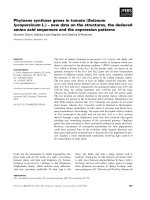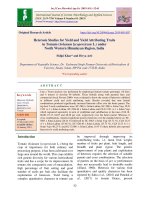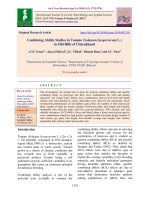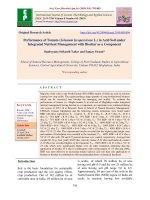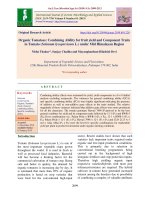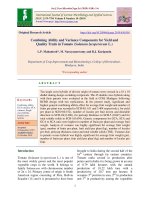Genetic variability in tomato germplasm (solanum lycopersicum l ) using morphological characteristics and simple sequence repeat (SSR) markers
Bạn đang xem bản rút gọn của tài liệu. Xem và tải ngay bản đầy đủ của tài liệu tại đây (1.79 MB, 113 trang )
KWAME NKRUMAH UNIVERSITY OF SCIENCE AND TECHNOLOGY
KUMASI, GHANA
SCHOOL OF GRADUATE STUDIES
DEPARTMENT OF CROPS AND SOIL SCIENCES
GENETIC VARIABILITY IN TOMATO GERMPLASM (Solanum
lycopersicum L.) USING
MORPHOLOGICAL CHARACTERISTICS AND SIMPLE SEQUENCE
REPEAT (SSR) MARKERS
JACINTA ADOMA OPOKU
AUGUST, 2015
GENETIC VARIABILITY IN TOMATO GERMPLASM (Solanum lycopersicum
L.) USING MORPHOLOGICAL CHARACTERISTICS AND SIMPLE
SEQUENCE REPEAT (SSR) MARKERS
A Thesis submitted to the Department of Crop and Soil Sciences, Faculty of
Agriculture, Kwame Nkrumah University of Science and Technology in Partial
Fulfilment of the Requirements for the Degree of
MASTER OF PHILOSOPHY
IN
AGRONOMY (PLANT BREEDING)
JACINTA ADOMA OPOKU
(BSc. Hons. Agriculture)
AUGUST, 2015
DECLARATION
I hereby declare that this work is a direct result of my field and laboratory research
undertaken and are supported by cited references in relation to other previous and
similar work performed and therefore, this thesis has not been presented anywhere
for a degree. All references to other works have been duly acknowledged.
Jacinta Adoma Opoku
(Student ID: 20288128)
……………………
Signature
……………..
Date
Prof. Richard Akromah
(Supervisor)
……………………
Signature
……………..
Date
Dr. Charles Kwoseh
(Co-Supervisor)
……………………
Signature
……………..
Date
……………………
Signature
……………..
Date
Certified by:
Dr. Enoch Adjei Osekre
(Head of Department)
i
ABSTRACT
Tomato is an essential ingredient in the daily diets of majority of Ghanaians and is
cultivated in almost all the agro-ecological zones in Ghana, however, not much
information is available on the genetic and morphological variability of tomatoes
cultivated by farmers. The need for varietal identification of tomato cannot be overemphasised. It was therefore, necessary to collate information and collect tomato
genotypes from the farmers for morphological and molecular evaluation to assess the
variations among and within the genotypes. A survey was conducted and semi
structured questionnaires administered to obtain information about farmers’
knowledge of varietal differences, preferences and production practices and
constraints. Preferred tomatoes were documented and fruits were obtained from the
farmers’ field to extract seeds for the study. A pot experiment was conducted to
study the genetic variability among and within 12 tomato genotypes obtained from
the farmers in three-selected tomato growing areas, namely Afari, Akomadan and
Kumawu and their environs in Ashanti Region and planted in a randomised complete
block design. DNA was extracted from eight (8) plants per genotype without bulking
to check the purity of the genotypes using the CTAB method with modification by
Takrama, (2000) CRIG adopted by Kirkhouse Trust Mobile Laboratory. Data taken
included 16 qualitative and 16 quantitative traits and scored using AVRDC
descriptor list with additions from the IPRGI descriptor list. It was realised that most
(65 %) of the farmers saved seeds from previous harvest for the subsequent planting.
Analysis of variance revealed highly significant difference (P≤ 0.01) among the
genotypes for all quantitative traits studied except plant height and number of
diseased and pest damaged fruits. Genotypic (GCV) and phenotypic coefficient of
variation (PCV) were high but narrow for most of the traits studied except for days to
ii
first flowering, days to 50 percent flowering, 100 percent flowering and plant height
which recorded lower phenotypic and genotypic coefficients of variation (PCV and
GCV), indicating the little environmental influence and hence, highly heritable.
Genotypes with higher fruit yield per plant (PF-AF and PM-AF) were from Afari and
its environs. The correlation analysis indicated that number of fruits per plant was
highly significant and positive with fruit yield per plant. Similar observation was
made with plant height and days to 50 % flowering. The SSR markers were highly
informative as generated by the PowerMaker V3.25 software. NTSyS PC software
2.2 grouped the 96 DNA samples of the 12 genotypes into two major groups. The
samples were reduced to 48 for clear dendrogram. Samples from DW-KU were all
put into one group while the rest were in the other group. The outcome of this study
should be useful to manage the germplasm conservation and future tomato genetic
improvement. However, all the genotypes may be cultivated over time at different
locations on field to ascertain their stability and purity.
iii
DEDICATION
To the glory of God, I dedicate this thesis to my uncle, Mr. Akwasi Adjei Adjekum.
iv
ACKNOWLEDGEMENT
I am forever grateful to the Almighty God for His protection throughout my studies. I
wish to express my sincere gratitude to my supervisors: Prof. Richard Akromah
(Provost, College of Agriculture and Natural Resources, KNUST) and Dr. Charles
Kwoseh (Head of Crop and Soil Science Department, KNUST) for their adept
supervision and support that enabled me to complete this research successfully. I
thank Dr Daniel Nyadanu,(Crop and Soil Sciences Department, KNUST), Dr.
Amoah (CRI, Fumesua), Dr. Francis Appiah (Head of Horticulture Department,
KNUST), Dr. B. K. Banful (Horticulture Department, KNUST), Mr. Prince Pobi
Owusu and all the lecturers and Staff of Department of Crop and Soil Sciences for
their incessant support, affection and encouragement. I acknowledge the following
individuals for their immense technical support; Mr. Ben Armooh (CRIG, Tafo), Mr.
Fuseini, Jamal, Ruchia (Biotechnology Lab), Mr. Koranteng, Mr. Osei, Mr. Malik,
Bismark, Pieterson, Eunice and Jemima (Pathology Lab), I also thank David Gaikpa,
Kirpal, Ambrose, Ulzen, Gifty Marian, Naomi and Nana Yaw for their selfless
support in data taken and analysis. My utmost gratitude goes to my sponsors, AGRA
(Alliance for Green Revolution in Africa) for the financial support throughout the
Masters programme. May God replenish everything you all lost while supporting me.
To all my family and loved ones especially my mum, Georgina Cylacia Adjei, my
late father, Mr. Collins Opoku, Mad. Faustina Akoto, my sibblings, all my aunties,
uncle and cousins, I say God bless you profusely.
v
TABLE OF CONTENT
DECLARATION ......................................................................................................... i
ABSTRACT ................................................................................................................ ii
DEDICATION ........................................................................................................... iv
ACKNOWLEDGEMENT ......................................................................................... v
TABLE OF CONTENT ............................................................................................ vi
LIST OF FIGURES .................................................................................................. ix
LIST OF TABLES ..................................................................................................... x
LIST OF PLATES .................................................................................................... xi
LIST OF APPENDICES ......................................................................................... xii
CHAPTER ONE ........................................................................................................ 1
1.0 INTRODUCTION............................................................................................... 1
CHAPTER TWO ....................................................................................................... 4
2.0 LITERATURE REVIEW .................................................................................. 4
2.1
Introduction.......................................................................................................... 4
2.2
Tomato production............................................................................................... 4
Tomato production in the world ..................................................................... 4
Tomato Production in Ghana .......................................................................... 5
2.3
Types or groups of tomato ................................................................................... 6
2.4
Genotypes of tomatoes grown in Ghana .............................................................. 7
2.5
Genetic divergence .............................................................................................. 8
2.6
The tomato quality ............................................................................................... 9
2.7
Characterization ................................................................................................... 9
Morphological characteristics of Tomato ..................................................... 10
Molecular characterization............................................................................ 11
Marker Assisted Selection (MAS) ................................................................ 13
Molecular marker techniques ........................................................................ 14
Non - PCR based technique .......................................................................... 14
2.8
PCR-based techniques ....................................................................................... 16
Limitation of PCR ......................................................................................... 17
Optimal PCR-primers ................................................................................... 17
Amplified Fragment Length Polymorphism (AFLP) ................................... 18
vi
2.9
Simple Sequence Repeats (SSR) markers ......................................................... 19
2.10 Evaluation of molecular markers ....................................................................... 19
CHAPTER THREE ................................................................................................. 21
3.0 MATERIALS AND METHODS ..................................................................... 21
3.1
Introduction........................................................................................................ 21
Survey of tomato fields in selected major growing area and collection of
tomato genotypes .......................................................................................... 21
Tomato genotypes obtained from farmers’ fields in the selected major
growing areas ................................................................................................ 22
Extraction of tomato seeds from fruits collected from farmers during the
survey ............................................................................................................ 22
Field experiment: Evaluation of morphological characteristics of the tomato
genotype ........................................................................................................ 23
Soil used for the pot experiment ................................................................... 23
Nursery and transplanting of the tomato seedlings ....................................... 24
Agronomic practices ..................................................................................... 24
3.2
Data collected .................................................................................................... 24
Field layout and experimental design ........................................................... 25
3.3
Morphological data analysis .............................................................................. 25
Quantitative characters measured ................................................................. 27
Qualitative character studies ......................................................................... 29
3.4
Laboratory experiment: Evaluation of 12 tomato genotypes from major tomato
growing areas in the Ashanti Region of Ghana using SSR markers ................. 29
Genomic DNA extraction and purification ................................................... 31
DNA quality testing and quantification ........................................................ 32
Test run for SSR primers .............................................................................. 33
Molecular markers and polymerase chain reactions ..................................... 34
Agarose gel electrophoresis (AGE) .............................................................. 34
Gel scoring of DNA fragment....................................................................... 35
Statistical Data analysis ................................................................................ 35
vii
CHAPTER FOUR .................................................................................................... 37
4.0 RESULTS .......................................................................................................... 37
4.1
Information on Farmers and the Study Areas .................................................... 37
General socio-economic characteristics of the areas of study ...................... 37
Socio-demographic information on farmers and farming activities ............. 37
4.2
Agro-morphological traits of the selected tomato genotypes ............................ 41
Variability in qualitative traits ...................................................................... 41
Variability in quantitative traits .................................................................... 43
Cluster analysis of the morphological data ................................................... 51
4.3
Correlation among yield components ................................................................ 53
4.4
Summary Statistics about the SSR markers used ............................................... 55
Analysis of Molecular Diversity of the tomato genotypes ........................... 56
CHAPTER FIVE ...................................................................................................... 61
5.0 DISCUSSIONS .................................................................................................. 61
5.1
Introduction........................................................................................................ 61
5.2
Survey of tomato fields in selected major growing area and collection of
tomato genotypes ............................................................................................... 61
5.3
Agro-morphological traits of the tomato genotypes .......................................... 62
5.4
Phenotypic and genotypic coefficient of variation and heritability estimates ... 63
5.5
Morphological relationship among genotypes................................................... 64
5.6
Correlation of yield and yield component ......................................................... 65
5.7
Evaluation of SSR markers in tomato genotypes using dendrogram ................ 66
5.8
Genetic diversity within and among the genotypes ........................................... 66
CHAPTER SIX ........................................................................................................ 68
6.0 CONCLUSIONS AND RECOMMENDATION ............................................ 68
6.1
Conclusion ......................................................................................................... 68
6.2
Recommendation ............................................................................................... 70
REFERENCES ......................................................................................................... 71
viii
LIST OF FIGURES
FIGURE
PAGE
Figure 4.1: Percentage of Gender of Respondents ..................................................... 38
Figure 4.2: Dendrogram generated using based on 16 traits of the twelve (12) tomato
genotypes using UPGMA .................................................................................. 51
Figure 4.3: Dendrogram based on 12 SSR markers 48 tomato accessions using SM
similarity coefficient and UPGMA clustering ................................................... 60
ix
LIST OF TABLES
TABLE
PAGE
Table 3.1: List of tomato microsatellite markers used in the DNA fingerprinting .... 30
Table 4.1: Age distribution of farmers ....................................................................... 38
Table 4.2: Educational background............................................................................ 39
Table 4.3: Sources of seeds ........................................................................................ 41
Table 4.4: Mean performance of twelve tomato genotypes for vegetative and
reproductive traits............................................................................................... 45
Table 4.5: Means of morphological traits of the tomato genotypes ........................... 47
Table 4.6: Means of morphological traits of the tomato genotypes ........................... 49
Table 4.7: Range, broad sense heritability, phenotypic and genotypic coefficients of
variation of the quantitative traits measured ...................................................... 50
Table 4.8: Correlation among yield components ....................................................... 54
Table 4.9: Summary Statistics of twelve SSR Markers ............................................. 55
Table 4.10: Genotypes, codes and DNA sample numbers for generating dendrogram
............................................................................................................................ 57
Table 4.11: Clusters of DNA samples from dendrogram .......................................... 58
x
LIST OF PLATES
PLATE
PAGE
Plate 4.1: (A) Skin colour of ripened fruit, (B) external colour of immatured fruits,
external colour of matured fruits (C) and (D) various shapes of the transverse
section of the tomato .......................................................................................... 42
Plate 4.2: Glimpse of some phenotypic variations in the tomato genotypes ............. 52
Plate 4.3: Primer TGS0010 showing genetic diversity in 96 DNA samples ............. 59
Plate 4.4: Primer TGS0020 showing genetic diversity in 11 DNA samples ............. 59
xi
LIST OF APPENDICES
APPENDIX
PAGE
APPENDIX I: QUESTIONNAIRES FOR TOMATO FARMERS AT AGOGO,
AKOMADAN AND KUMAWU ...................................................................... 87
APPENDIX II: Analysis of Physical and chemical properties of soil ....................... 89
APPENDIX III: Morphological Characteristics observed in the experiment based on
IPGRI tomato descriptor (Darwin et al., 2003) .................................................. 90
APPENDIX IV: Survey Results ................................................................................ 92
APPENDIX V: Qualitative Traits Data in percentage ............................................... 94
APPENDIX VI: ANOVA for 16 quantitative traits ................................................... 96
APPENDIX VII: Dendrogram based on 12 SSR markers 96 tomato accessions using
SM similarity coefficient and UPGMA ............................................................. 99
xii
CHAPTER ONE
1.0
INTRODUCTION
Tomato (Solanum lycopersicum L.) belongs to the Solanaceae or nightshade family (Naz
et al., 2013). In the tropics, it is the most important vegetable crop (FAO, 2003) and the
second most important vegetable crop next to potato globally (FAOSTAT, 2014;
Fuseini, 2010; Al-Aysh et al., 2012).
In Ghana, tomato is an essential ingredient in the daily diets of majority of the
population. It can be consumed as fresh vegetable or in the processed form (Al-Aysh et
al., 2012). It can also be used in the preparation of various cuisines including soups,
sauces, stew, salad and other meals. Compared to other vegetables used in the country,
tomato is normally used in large quantities (Ellis et al., 1998). In the developed
countries, tomato is produced in larger quantities and processed. However, in most West
Africa, it is produced mainly for domestic consumption (Norman, 1992). The fruit is a
rich source of fibre, potassium, vitamins C and A (AVRDC, 2004; Murphy and
Trowbridge, 2011) and a good source of calcium, iron, phosphorus and sulphur. It is also
a major source of lycopene found in high concentrations in processed tomato products
(Di Mascio, 1998). Lycopene is an antioxidant known to combat premature aging
(Wener, 2000) and quenches free radicals (Simon, 1992). Other health benefits include
efficiency in neutralizing Reactive Oxygen Species (ROS), prevention of prostate
cancer, heart disease and high cholesterol (Murphy and Trowbridge, 2011; AVRDC,
2004).
1
Genetic variability is the first step of plant breeding for crop improvement which should
be available from germplasm, the reservoir of variability for different characters (Dar
and Sharma, 2011). Although tomato is cultivated in almost all the agro-ecological
zones in Ghana, not much information is available on their genetic and morphological
variability (Osei et al., 2009; Robinson and Kolavalli, 2010). The problem of varietal
identification in tomato by farmers cannot be over-emphasised (Blay, 1999). The
evaluation of genetic variability among and within populations of tomato genotypes can
be assessed by using morphological, biochemical and molecular characterization (Garcia
et al., 2004). Morphological characterization has been the popular tool used for the
improvement of new genotypes over the years where improved plants are developed by
solely selecting plants with desirable phenotypes. However, developing a new improved
plant genotype by ways of phenotypic selection can easily exceed 10 years and is highly
dependent on the environment for expression; hence, their ability to estimate genetic
diversity in plants is reduced (Brunlop and Finckh, 2010).
The development of DNA (molecular) markers has enhanced plant genetics and plant
breeding. These molecular markers are effective tools for efficient selection of desired
agronomic traits because they are based on the plant genotypes and are independent of
environmental variation (Franco et al., 2001). While there are several applications of
DNA markers in breeding, the most promising for cultivar development is the markerassisted selection (MAS) (Pervaiz et al., 2009).
Researchers have been estimating genetic variation in tomato landrace and cultivar
collections using several molecular techniques including Amplified Fragment Length
Polymorphism (AFLP), Restriction Fragment Length Polymorphism (RFLP), Random
2
Amplified Polymorphic DNA (RAPD) and Simple Sequence Repeats (SSR)
(Bredemeijer et al.,1998; Villand et al., 1998; Park et al., 2004 and Garcia-Martinez et
al., 2006). Comparatively, SSR provides co-dominant expression, highly reproducible,
locus-specific, high proportion of single-fragment amplification, high sensitivity that
allows distinctions even between closely related individuals (Bindler, 2007; Pervaiz, et
al., 2009) and cost-effectiveness (Loridon et al., 2005; Dongre and Parkhi, 2005;
Sharma and Sharma, 1999).
The main objective of the study was to determine the morphological and genetic
variability of tomato genotypes grown by farmers in selected areas in the Ashanti
Region of Ghana.
The specific objectives were to:
i.
document tomatoes genotypes grown by farmers in selected areas
ii.
determine the variations among the tomato genotypes using morphological
descriptors,
iii.
determine the genetic variability among the tomato genotypes using SSR
markers.
3
CHAPTER TWO
2.0
2.1
LITERATURE REVIEW
Introduction
Tomato is a typically red edible fruit (Yeboah, 2011). Solanaceae is so large and very
diverse with 98 genera and 2,700 species (Olmstead and Bohs, 2007). The species are
distributed in three subfamilies, Solanoideae (Solanum belongs to this subfamily),
Solanineae and Cestroideae.
2.2
Tomato production
Tomato production in the world
In 2013, tomato was estimated to be about 161.8 million tonnes in the world.
(FAOSTAT, 2014). It is recorded that, China produces about one quarter of the world’s
tomatoes, which makes them the most prominent producer followed by India, United
States and Turkey (FAOSTAT, 2014). In Africa, Egypt is the leading tomato producer
and the fifth producers in the world. Other major producers in Africa include Nigeria,
Tunisia and Morocco (Yeboah, 2011).
According to Nicole et al. (2009), there is an increased importance of tomato production
in the world which has led to expansion of acreages and exportation share of many
countries particularly to those located near the major importing countries. China
Business Intelligence Portal (2010) for instance reported that there was an increase in the
world’s area of tomato with processing tomatoes output by 115.6% year-on-year to
42.317 million tonnes because of the hiked price of tomato sauce in 2008.
4
Tomato adapts to a wide range of climatic conditions from temperate to hot humid
tropics even though relatively cool, dry climate are required for high yield and better
quality. (Srinivasan, 2010). There is limitation in the production of tomatoes during the
hot-wet season in tropical and subtropical climates which increases disease incidence
(Nicole et al., 2009).
Tomato Production in Ghana
Ghana’s commitment to the tomato sector began in the 1960s. However, tomato
production has failed to reach its potential in terms of the ability to sustain the few
processing plants, improving the livelihoods of the households involved in tomato
production and the tomato commodity chain. (Robinson and Kolavalli, 2010).
Despite government interventions, farmers do not grow the right quality (prefer planting
local genotypes) and could not produce the right quantity for commercial agro
processing. Robinson and Kolavalli (2010) observed decline in the tomato production
even though Ellis et al. (1998) reported average increase in tomato production within a
year (three times a year). The average yields of tomato in Ghana is low, typically, less
than 10 t/ha due to production seasonality, high perishability, poor market access and
competition among the farmers and also from imports, some farmers are unable to sell
their tomatoes, which are left to rot in their fields. Ellis et al. (1998) also reported that,
the yield on a farm is low between 7.5 – 10 t/ha. However, in this entire situation, they
maintain that many farmers in Ghana prefer to cultivate tomatoes to other crops since
the production is profitable (Robinson and Kolavalli, 2010).
5
2.3
Types or groups of tomato
Tomato has been grouped into two main types, hybrid and open-pollinated which often
confuse new tomato growers (Sacco, 2008). The desirable traits of either parent of a
hybrid include size of fruit; resistance to some diseases and taste whilst the negative
aspect is where, their seeds could regress to either of the parent plant or would become
sterile and will not produce seeds at all. According to Gould (1992), even though not
clearly documented, tomatoes were perhaps small-fruited initially. Later stress on
breeding for smooth-skinned cultivars pre-supposed that early cultivars had rough skin.
Open-pollination enhances gradual changes in the plant's production and immunities
(Edlin, 2009). This, therefore, means that new genotypes are obtained over a period
through open pollination, which averts further out-crossing. Heirloom tomatoes are
described as open-pollinated plants, developed directly from the seed of a previous fruit,
from a genotype that has been around for 50 years or more (Vavrina et al., 2003).
Despite the description, one chooses for heirloom because they all exhibit one peculiar
quality, open pollination (Edlin, 2009). Domesticated tomatoes (Solanum lycopersicum)
are naturally self-pollinating and usually do not outcross. Hence, they quickly become
homogenous and produce ‘true-to-type’ seed (Edlin, 2009). Colours of heirlooms vary
from yellow, red, orange, purple, white, green, and bicolour combinations of them all.
There is also wide genotype in their shapes and sizes, which ranges from tiny cherries to
huge two-pounders in the same garden, along with egg, flattened, globe, oblong,
pumpkin, pear, and pepper shaped fruits (Edlin, 2009).
6
2.4
Genotypes of tomatoes grown in Ghana
There are many tomato genotypes grown in Ghana. These include Bolga and Ashanti
(Adubofour et al., 2010) and Powerano (Robinson and Kolavalli, 2010), as genotypes
mostly grown in Brong Ahafo Region under rain-fed conditions. Other genotypes are
‘Rasta’, ‘Fadebegye’, ‘Mmoboboye’ and ‘Amo’ as described by Osei et al. (2014),
Nimagent F1 supplied by Trusty Foods, grown under both irrigated and rain- fed
conditions,’ In Greater Accra Region Nimagent and ‘Ada lorry tyre’ are grown under
rain-fed conditions. However, ‘Wosowoso’, Roma VF, Cac J, Pectomech, Laurano,
Pectomech VF, Tropimech, Rio Grande, were the genotypes recommended by Ministry
of Food and Agriculture of Ghana (2008) which were obtained by farmers from
reputable seed dealers and other farmers. Robinson and Kolavalli (2010) found
Pectomech genotype suitable for processing and preferred by consumers hence achieved
premium price over the local genotypes. According to Clottey et al. (2009), genotypes
Pectomech, Tropimech, and Roma grown mostly under rain-fed conditions in the
Greater Accra Region were also found to be the major tomato genotypes grown in Vea
in the Upper East Region, a notable tomato growing area. Some genotypes were
recognised as major local open pollinated that farmers can wash and recycle. These
included genotypes such as ‘Power’ Powerano, Rasta’and Wosowoso, with Powerano
often being preferred due to its high tolerance and/or resistance to diseases. Ellis et al.
(1998) reported that the `Power' genotype was the genotype mostly cultivated in Ghana.
7
2.5
Genetic divergence
The evaluation of genetic variability using quantitative traits has been of major
significance in many contexts particularly, in distinguishing well defined populations.
Heterogeneous sets of groups exist in a self-pollinated crop in a germplasm since each
group is homozygous within itself (Yu et al., 2000). It is critical to select parents in such
crops for breeding programme because, the success of such programme depends upon
the segregants of hybrid derivatives between the parents, mostly when the aim to
improve the quantitative characters such as yield (Yu et al., 2000). To help the breeder
in the process of identifying the parents, several methods of divergence analysis based
on quantitative traits been proposed (Walker and White, 2001). Among them,
Unweighted Pair Group Method with Arithmetic averages (UPGMA) is one of the most
prevalent procedures and an effective method to measure the degree of variability
among genotypes, based on their pairwise similarities in relevant traits (Legendre and
Legendre, 1998).
Currently, UPGMA has been mostly used to produce lead trees for more advanced
phylogenetic reconstruction algorithms even though it was designed initially for use in
protein electrophoresis studies (Walker and White, 2001). The UPGMA algorithm
constructs a rooted tree (dendrogram) that reflects the structure present in a pairwise
similarity or a dissimilarity matrix). The closest two clusters are joined into a higherlevel cluster at each step. The average of all distances between any pairs of objects “x”
in A and “y” in B is taken to be the distance between the two clusters A and B. The
mean distance between elements of each cluster is shown below:
8
1
The
A
∑∑ d(x,y)
B xϵA yϵB
This method is generally attributed to Sokal and Michener (1958). Fionn Murtagh
(1983) found a time optimal (n2) time algorithm to construct the UPGMA tree.
2.6
The tomato quality
The improvement of crop species has been a principal human goal since cultivation
began. Tomato is a major economically important crop with several characteristics used
in establishing a model system for segmentation of genetic factors of quantitative trait
loci (QTL). Several wild-related species in tomato have been confirmed to be
unexploited sources of appreciated genetic variability. These include pathogenresistance genes, and industrial and nutritional quality traits. Recent medical research on
fruit compositional quality for social health has also motivated crop improvement
strategies (Pestana et al., 2003). This is seen in the interest shown to enhance antioxidant
compounds present in fruit and vegetables, which may help, prevent chronic diseases
such as cancer, arthritis and heart disease in the past century (Harrigan et al., 2007). The
tomato quality traits of interest to both fresh market and processing tomato industries
include fruit size, shape, total solids, colour, firmness, nutritional quality and flavour.
The pH, titratable acidity, vitamin contents and low seed load are the other important
fruit quality characteristics of tomato (Foolad, 2007).
2.7
Characterization
The expression of plants of highly heritable characters is determined by characterization.
These characters range from phenotypical or agronomical triats to seed proteins or
9
molecular markers (Valpuesta and Botella, 2004). Characterization based on differences
between morphological and phenological of high heritability is approximated. The
variations in the germplasm of the plants are estimated, therefore the diversity in a
collection of germplasm can only be said to have been studied when characterization is
done. This kind of variations can only be expressed by molecular markers. Such
variation may also include characteristics whose expression is little influenced by the
environment (Bhatt et al., 2004). Suitable characterization for morphologic and
agronomic traits is important to facilitate the use of germplasm by breeders. This could
be achieved by characterizing germplasm accessions of all crops for morphological and
agronomic traits in batches over the years (Tanksley, 2004).
Morphological characteristics of Tomato
Traditionally, cultivar identification and morphological characterization in tomato have
been done by evaluating stem, flower and fruit characteristics (Susic et al., 2002). Susic
et al. (2002) acknowledged the significance of morphological characterization in
identifying duplicate accessions, discovery of exceptional traits and in conservation of
the population structure, thus saving on storage space and streamlining selection by plant
breeders. It has been used for studies of genetic diversity patterns and correlation with
characteristics of agronomic importance (CIAT, 2007). Tomato cultivars are normally
renowned based on morphological traits that have a wide variability of botanic
characteristics.
10
2.7.1.1 Descriptor list of tomato
Descriptor lists are those characteristics by which germplasm can be identified and its
prospective usefulness determined (IPGRI, 2003). Descriptors used for characterization
allow comparatively easy discrimination among phenotypes. Those related to
phenotypic traits mostly relate to the morphological description of the plant and its
architecture (CIAT, 2007). Standard descriptor lists provide an international format
thereby producing a universally understood language for plant genetic resource data
(IPGRI, 2003).
2.7.1.2 Limitations in morphological studies
There are limitations in assessing tomato diversity morphologically due to the tendency
of a species changing in appearance substantially in response to environment
(Weerasingh et al., 2008). They identified disease as one of the key environmental
factors for the conservation of genetic variations in plant populations. Pathogens such as
viruses can tremendously affect the structure, diversity and functioning of the plant
populations (Brummell and Harpster, 2001). Variations in environmental conditions
could permit variations in results obtained if morphological characterization is repeated
spatially and periodically (Miller and Tanksley, 1990). Therefore, observation of genetic
diversity based on only high morphological diversity among the tomato accessions may
not be conclusive indication of genetic diversity (Zamir, 2001).
Molecular characterization
It is very imperative to complement morphological characterization with molecular
characterization due to changes in environment and sometimes mutation in tomatoes.
11
